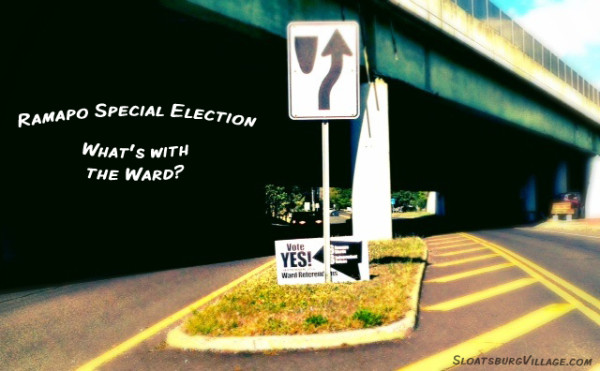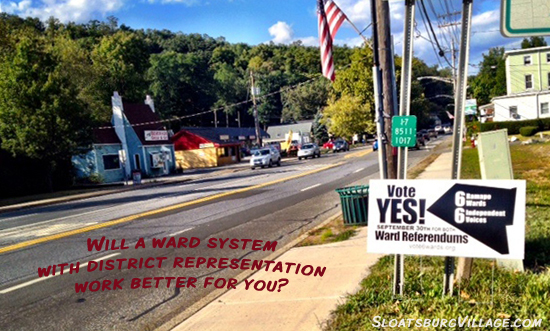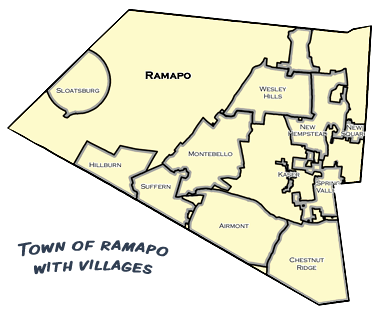
Town of Ramapo voters go to the polls on Tuesday, September 30 to give voice to two court ordered ballot measures related to how residents want to be represented at Town Hall.
The upcoming Ramapo Ward and Council members Special Election continues to create buzz and could change the electoral face of Ramapo.
Would a ward system further balkanize Ramapo residents and the various communities? Or would a ward system establish community-based districts and produce town council members who represent particular neighborhood issues and interests?
After many years of trying to get the initiative put on the ballot, Ramapo voters go to the polls Tuesday, September 30 to answer the siren call issue, perhaps once and for all.
The Town of Ramapo will act as a sort of board of elections for the ward and council member ballot measures, as directed by New York Supreme Court Justice Margaret Garvey in her late July ruling on the validity of the petitions for the two referendums brought before the court by Ramapo residents Michael Parietti and Robert Romanowski. If instituted by popular vote, ward districts will be determined by the Rockland County Board of Elections.
Question 1:
Shall the number of councilmen or councilwomen of the Town of Ramapo be increased from four to six?
Question 2:
Shall the ward system be established for the election of Councilmen or Councilwomen in Ramapo?
 The Journal News reporter Akiko Matsudo has done an admirable job of reducing the sprawling Special Election issues into digestible bites. The issue is complex and culturally freighted for many voters — where you live in the town just might determine how you feel about a ward. Will it correct a perceived advantage of block voting in densely Jewish areas of the town? It would counterbalance voter block pressure in wards that don’t contain that particular voter voice or population.
The Journal News reporter Akiko Matsudo has done an admirable job of reducing the sprawling Special Election issues into digestible bites. The issue is complex and culturally freighted for many voters — where you live in the town just might determine how you feel about a ward. Will it correct a perceived advantage of block voting in densely Jewish areas of the town? It would counterbalance voter block pressure in wards that don’t contain that particular voter voice or population.
Agudath Israel of America, an Orthodox Jewish policy organization based in Manhattan, said “the bulk of the Orthodox Jewish community would be concentrated in only two of six districts under the ward system.
Some have stated that the whole process is “radical and risky” and essentially a “pig in a poke” which will create more problems than it solves. Proponents of the ward system believe it will democratize a seriously skewed Ramapo electoral process by constructing a framework that promotes local voices and values over vocal minority rule.
Current Ramapo council members include Patrick Withers, Yitzchok Ullman, Daniel Friedman, and Brendel Logan — some communities in the town rarely catch sight of a council member and many voters really have no idea exactly who or what their council members represent.
There’s a certain comfort to the winner take-all popular vote. And don’t engaged, cohesive voter coalitions win out in the end anyway? Could a Western Ramapo coalition block vote be a more effective voice for constituents than a ward system that might not include all the Western Ramapo villages and communities in the same ward? Food for thought.
What the yeas say
Suffern Mayor Trish Abato released a statement this past week supporting the ward system, saying that wards would better serve “specific geographic segments of the population” thereby creating accountability and fairness.
A ward system is a form of direct representation and allows representatives to serve and relate to the concerns and issues specific to their residents. The idea is that majority rules whereby council members vote the will of their residents. Currently, council members are elected at-large and might not be familiar with particular areas of the town.
Assemblywoman Ellen Jaffe (D-Suffern) and Assemblyman Ken Zebrowski (D-New City) came out in favor of a Ramapo ward system, with Jaffe stating “A ward system would allow town officials to be more responsive to local issues. It would provide more opportunity for residents to have a place at the table and their voices heard.”
Local website Vote6Wards.org has been the leading pro-ward information source, quickly helping to clarify the issue for many. Sparked by her firm belief that Tuesday’s vote is a one-time opportunity to change town electoral dynamics, Village of Montebello resident Deb Munitz said residents should ask themselves: “Do I feel comfortable about what’s going on in the Town of Ramapo and am I being represented?” She believes a ward system will allow residents to know just who their representative is while encouraging stronger communication with the town government.
“Everyone is suing the town of Ramapo,” Munitz said about various on-going and frequent town disputes. “Can’t we make better decisions in the first place?” she asked.
Facts, considerations and just who draws ward districts
Only a handful of towns (11) in New York use the ward system outside of New York City, where there’s often diverse demographics in smaller geographic locations. One major deterrent is that voters don’t know what ward boundaries will be before the vote.
New York Town Law, fortified by a legal memorandum from the NY State Office of General Council, makes it very clear that the Rockland County Board of Elections is authorized to draw any election districts for the Town of Ramapo. The General Council memo outlined the ward issue, setting out how the issue is to be decided in community elections. If established, wards would be determined “so far that the number of voters in each ward shall be approximately equal,” according to sections 81 and 85 of the Town Law. The Board of Elections would use overall population and voter registration figures to determine wards.
Town Law says that a ward system is considered established on the date when the board of the county elections files a map “showing in detail the location of each ward and the boundaries thereof” – Town Law section 85.
With a population of approximately 130,000 that includes 60,000 plus registered voters, drawing six Ramapo wards would involve figuring out how to segment districts into wards with a total population of some 20,000 residents and 11,000 registered voters. A tricky feat indeed.
Mix and match, or Ramapo might end up with no ward but 6 council members
Consider: What Happens if the ward system is voted down but the town votes in 2 more council members for a total of 6? Western Ramapo could end up with two additional council members many have never heard of and who have never seeing in this neck of the woods.
Or what say the ward system is voted in but the 4-to-6 council member increase measure fails — the town will then by default be divided into 4 wards. Proponents of the measures ultimately want yeas for both referendums which would create six wards with six council members and the one town supervisor, always the one supervisor elected via an open-town wide vote.
If all fails, all stays the same, though the populace might feel a bit itchy but more enlightened. The whole effort then may possibly continue groundswell for a cohesive Western Ramapo coalition that itself would wield a mighty megaphone.
Citations for information include, among others, Vote6Wards.org, Town of Ramapo resolution, Town of Ramapo attorney’s office, New York State Town Law, the Rockland County Board of Elections, and individuals active in and following Ramapo and Rockland issues.
This article was updated.




